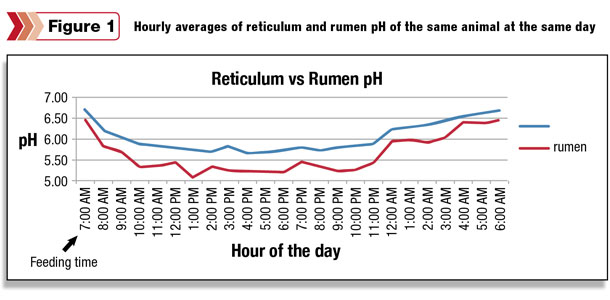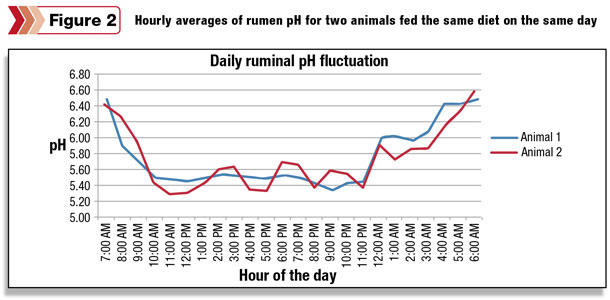Ruminal acidosis has been simply categorized into two stages: subacute ruminal acidosis (SARA), when pH is below 5.8, and acute ruminal acidosis, when pH is below 5.2. The cost of acidosis has been estimated to be between $1 and $2 per head per day; thus, its prevention has a significant economic impact.
In the past few decades, technology has entered the animal husbandry sector in a more aggressive way, and the tendency is to see an increase on its penetration. In the dairy industry especially, it is common to see “the ladies” showing off their jewelry: “ankle bracelets” to track their activity and a “collar” or “earring” to monitor their chewing behavior.
The use of those devices has improved estrus detection, herd management and facilitated the identification of potential metabolic disorders.
Rumen in-dwelling continuous-reading data loggers (rumen pH sensors) have been widely used by scientists in universities and research institutions, but its application in the field has been limited.
Today, there are approximately 10 different rumen pH sensors on the market; normally, their size varies between 4 to 6 inches long and 1 to 3 inches in diameter.
Currently, the device records rumen pH and temperature at a specific time interval, but research has been advancing and new capabilities could be available in the near future.
Past research has shown that pH varies throughout the different regions of the reticulorumen, so it is important to understand at which location “rumen pH” is being monitored.
One can place a sensor through a cannula, and this will make its way to the bottom of the rumen (ventral sac) and could potentially migrate to the reticulum. Another way would be to tie the sensor to the cannula lid by a rope, and now the sensor will oscillate in the middle of the rumen.
In a commercial situation, the access to cannulated animals is limited, so the only way to introduce these type of sensors is orally, which will end up at the bottom of the reticulum, or if the sensor has extension arms, it will fluctuate on the rumen mat.
More important than which sensor to use is understanding which “rumen pH” has been recorded and how this is correlated with the observed performance data.
Here is an example of the difference between average hourly reticulum and rumen pH in the same animal on the same day. Figure 1 on page 43 shows that reticulum and rumen pH follow a similar pattern throughout the day, and normally, reticulum pH is higher and more stable than rumen pH.

One interesting fact not shown in Figure 1: The temperature of the reticulum will drop as the animal drinks water, but this phenomenon is not observed with rumen temperature.
It is important to note that Figure 1 is a simplified illustration of 1,440 reticulum and 1,440 rumen pH values captured in one day. Using the raw values from this exercise, one would calculate an average reticulum pH of 6.03 and a rumen pH of 5.63.

Average ruminal pH value should be interpreted with caution; here is an example (Figure 2) of two animals fed the same diet on the same day. Both animals have an average pH of approximately 5.70, but throughout the day the fluctuation of pH is higher for animal 2 than for animal 1.
Examples of such a difference in ruminal pH fluctuation between animals with similar average rumen pH have been described, and there is a published mathematical method to calculate ruminal pH fluctuation.
Researchers have shown that feedlot steers and lactating cows do not perform at maximum when dietary and environmental conditions are not in balance. In this case, avoiding great fluctuation of daily ruminal pH could lead to ideal rumen health, and consequently, optimum performance.
The available rumen pH sensors still need to improve user interface capability, and the cost of the equipment should be more economically feasible in order for a producer to invest in such technology.
Today, ration formulation systems do a good job predicting relative changes in rumen pH based on dietary changes, and this tool should be used when evaluating a potential dietary modification.
We should always keep in mind that the most advanced technology is behind our eyes, so observing and listening what the animals are telling you is a technology that will never be outdated. ![]()
Gustavo Cruz
Ruminant R&D Manager
Cargill Animal Nutrition





